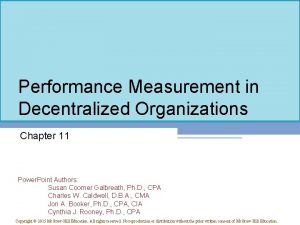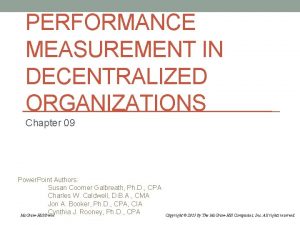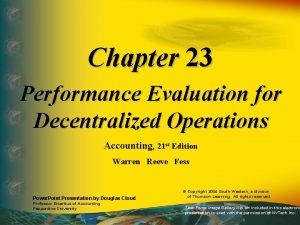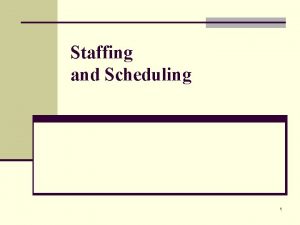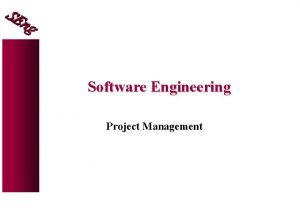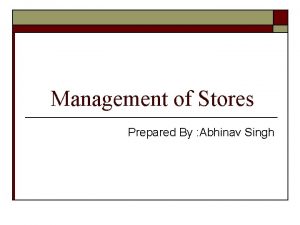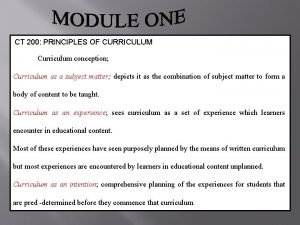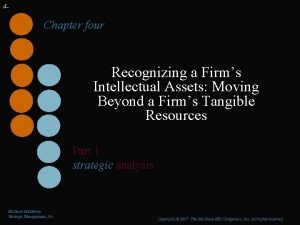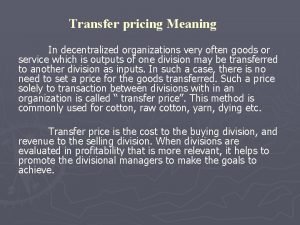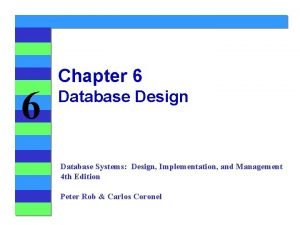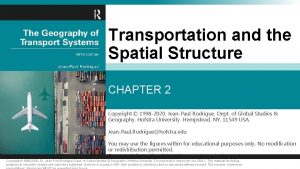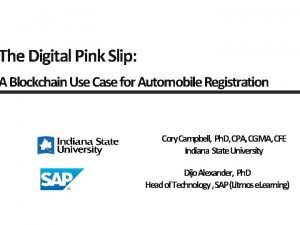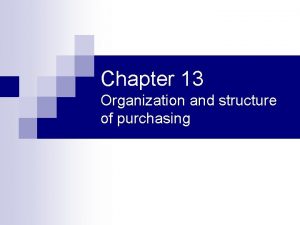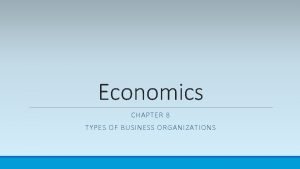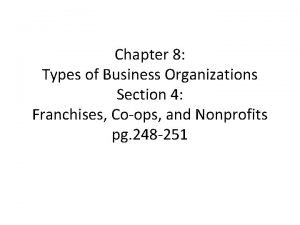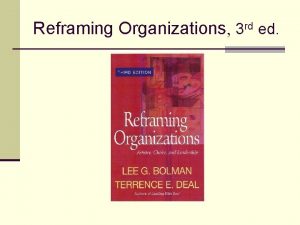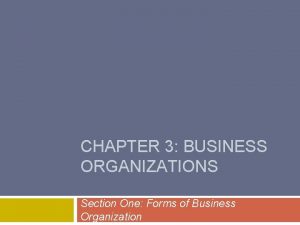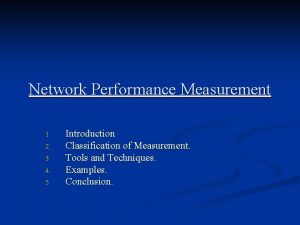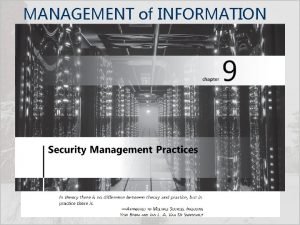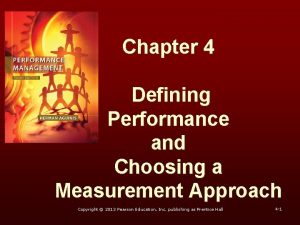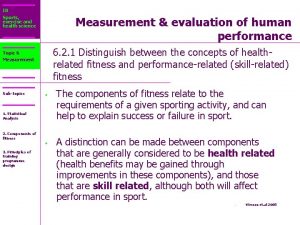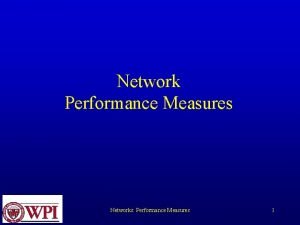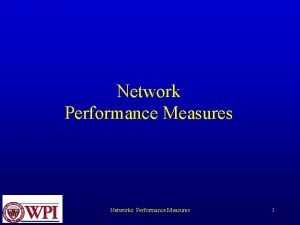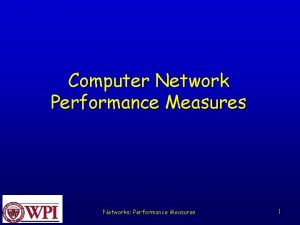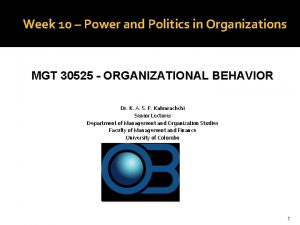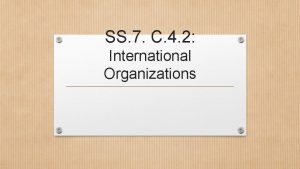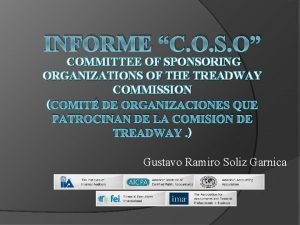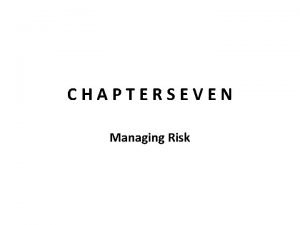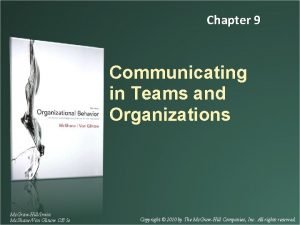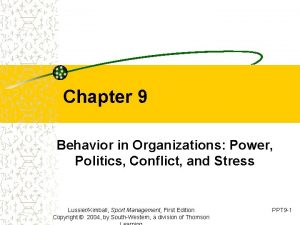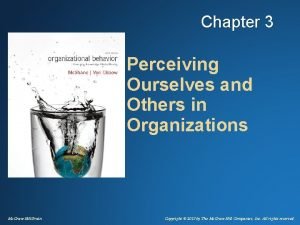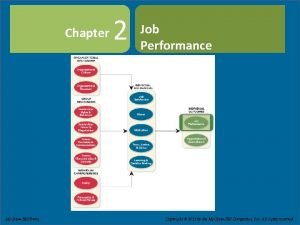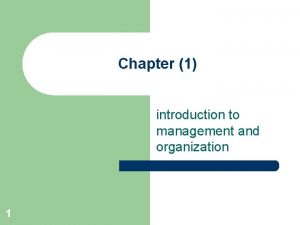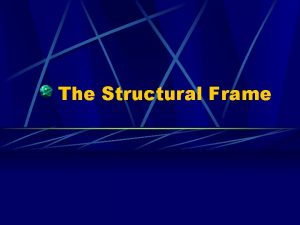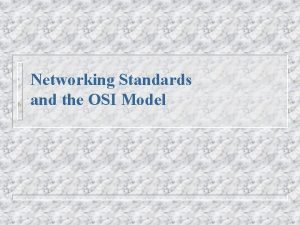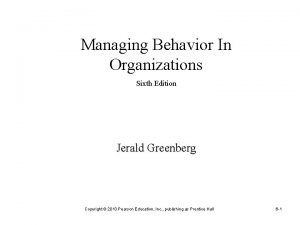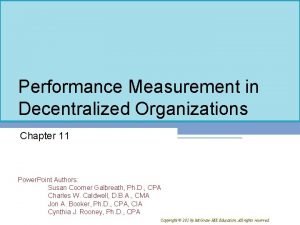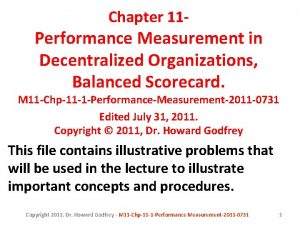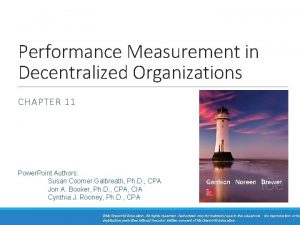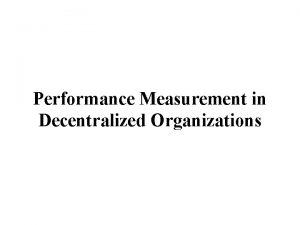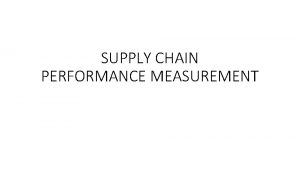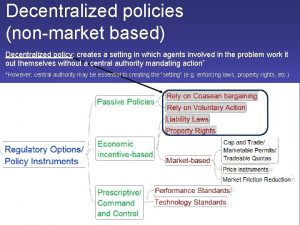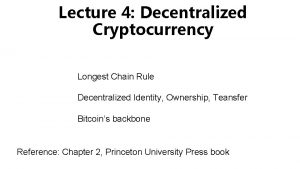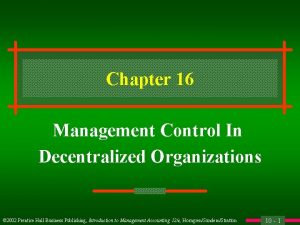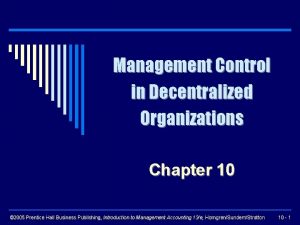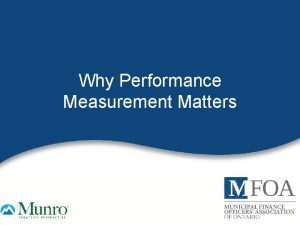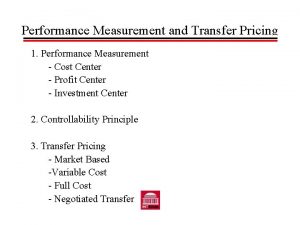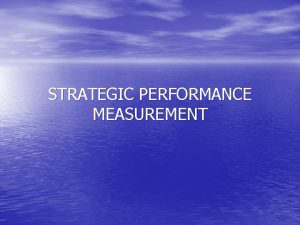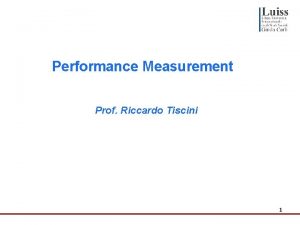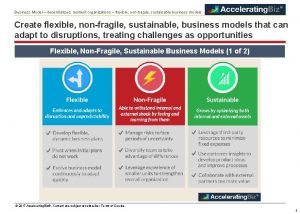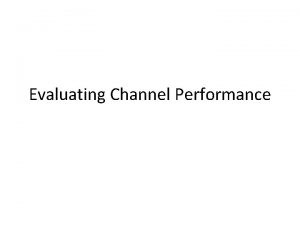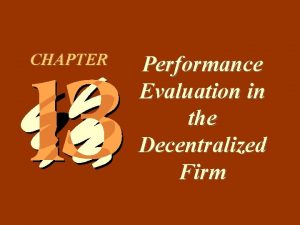Performance Measurement in Decentralized Organizations Chapter 13 2015













































































- Slides: 77

Performance Measurement in Decentralized Organizations Chapter 13 © 2015 Mc. Graw-Hill Education

Decentralization in Organizations Benefits of Decentralization Lower-level managers gain experience in decision-making. Top management freed to concentrate on strategy. Decision-making authority leads to job satisfaction. Lower-level decisions often based on better information. Lower level managers can respond quickly to customers. © 2015 Mc. Graw-Hill Education Garrison, Noreen, Brewer, Cheng & Yuen 1

Decentralization in Organizations Lower-level managers may make decisions without seeing the “big picture. ” Lower-level manager’s objectives may not be those of the organization. © 2015 Mc. Graw-Hill Education May be a lack of coordination among autonomous managers. Disadvantages of Decentralization May be difficult to spread innovative ideas in the organization. Garrison, Noreen, Brewer, Cheng & Yuen 2

Cost, Profit, and Investments Centers Cost Center Cost, profit, and investment centers are all known as responsibility centers. © 2015 Mc. Graw-Hill Education Profit Center Investment Center Responsibility Center Garrison, Noreen, Brewer, Cheng & Yuen 3

Cost Center A segment whose manager has control over costs, but not over revenues or investment funds. © 2015 Mc. Graw-Hill Education Garrison, Noreen, Brewer, Cheng & Yuen 4

Profit Center A segment whose manager has control over both costs and revenues, but no control over investment funds. Revenues Sales Interest Other Costs Mfg. costs Commissions Salaries Other © 2015 Mc. Graw-Hill Education Garrison, Noreen, Brewer, Cheng & Yuen 5

Investment Center Corporate Headquarters A segment whose manager has control over costs, revenues, and investments in operating assets. © 2015 Mc. Graw-Hill Education Garrison, Noreen, Brewer, Cheng & Yuen 6

Responsibility Centers Investment Centers Cost Centers Superior Foods Corporation provides an example of the various kinds of responsibility centers that exist in an organization. © 2015 Mc. Graw-Hill Education Garrison, Noreen, Brewer, Cheng & Yuen 7

Responsibility Centers Profit Centers Superior Foods Corporation provides an example of the various kinds of responsibility centers that exist in an organization. © 2015 Mc. Graw-Hill Education Garrison, Noreen, Brewer, Cheng & Yuen 8

Responsibility Centers Cost Centers Superior Foods Corporation provides an example of the various kinds of responsibility centers that exist in an organization. © 2015 Mc. Graw-Hill Education Garrison, Noreen, Brewer, Cheng & Yuen 9

Prepare a segmented income statement using the contribution format, and explain the difference between traceable fixed costs and common fixed costs. © 2015 Mc. Graw-Hill Education Garrison, Noreen, Brewer, Cheng & Yuen 10

Decentralization and Segment Reporting An Individual Store Popular Foods A segment is any part or activity of an organization about which a manager seeks cost, revenue, or profit data. © 2015 Mc. Graw-Hill Education A Sales Territory A Service Center Garrison, Noreen, Brewer, Cheng & Yuen 11

Superior Foods: Geographic Regions Superior Foods Corporation $500, 000 Singapore $55, 000 Malaysia $70, 000 Shanghai $120, 000 China $300, 000 Beijing $85, 000 Taiwan $75, 000 Guangzhou $50, 000 Hangzhou $45, 000 Superior Foods Corporation could segment its business by geographic region. © 2015 Mc. Graw-Hill Education Garrison, Noreen, Brewer, Cheng & Yuen 12

Superior Foods: Customer Channel Superior Foods Corporation $500, 000 Convenience Stores Supermarket Chains Wholesale Distributors $80, 000 $280, 000 $100, 000 Cold Store $85, 000 Mart Place $40, 000 Buy n Save $90, 000 Drugstores $40, 000 Huge $65, 000 Superior Foods Corporation could segment its business by customer channel. © 2015 Mc. Graw-Hill Education Garrison, Noreen, Brewer, Cheng & Yuen 13

Keys to Segmented Income Statements There are two keys to building segmented income statements: A contribution format should be used because it separates fixed from variable costs and it enables the calculation of a contribution margin. Traceable fixed costs should be separated from common fixed costs to enable the calculation of a segment margin. © 2015 Mc. Graw-Hill Education Garrison, Noreen, Brewer, Cheng & Yuen 14

Identifying Traceable Fixed Costs Traceable costs arise because of the existence of a particular segment and would disappear over time if the segment itself disappeared. No computer division means. . . © 2015 Mc. Graw-Hill Education No computer division manager. Garrison, Noreen, Brewer, Cheng & Yuen 15

Identifying Common Fixed Costs Common costs arise because of the overall operation of the company and would not disappear if any particular segment were eliminated. No computer division but. . . © 2015 Mc. Graw-Hill Education We still have a company president. Garrison, Noreen, Brewer, Cheng & Yuen 16

Traceable Costs Can Become Common Costs It is important to realize that the traceable fixed costs of one segment may be a common fixed cost of another segment. For example, the landing fee paid to land an airplane at an airport is traceable to the particular flight, but it is not traceable to first-class, business-class, and economy-class passengers. © 2015 Mc. Graw-Hill Education Garrison, Noreen, Brewer, Cheng & Yuen 17

Segment Margin Profits The segment margin, which is computed by subtracting the traceable fixed costs of a segment from its contribution margin, is the best gauge of the long-run profitability of a segment. Time © 2015 Mc. Graw-Hill Education Garrison, Noreen, Brewer, Cheng & Yuen 18

Traceable and Common Costs Fixed Costs Don’t allocate common costs to segments. Common Traceable © 2015 Mc. Graw-Hill Education Garrison, Noreen, Brewer, Cheng & Yuen 19

Levels of Segmented Statements Webber, Inc. has two divisions. Let’s look more closely at the Television Division’s income statement. © 2015 Mc. Graw-Hill Education Garrison, Noreen, Brewer, Cheng & Yuen 20

Levels of Segmented Statements Our approach to segment reporting uses the contribution format. Cost of goods sold consists of variable manufacturing costs. Fixed and variable costs are listed in separate sections. © 2015 Mc. Graw-Hill Education Garrison, Noreen, Brewer, Cheng & Yuen 21

Levels of Segmented Statements Our approach to segment reporting uses the contribution format. Contribution margin is computed by taking sales minus variable costs. Segment margin is Television’s contribution to profits. © 2015 Mc. Graw-Hill Education Garrison, Noreen, Brewer, Cheng & Yuen 22

Levels of Segmented Statements © 2015 Mc. Graw-Hill Education Garrison, Noreen, Brewer, Cheng & Yuen 23

Levels of Segmented Statements Common costs should not be allocated to the divisions. These costs would remain even if one of the divisions were eliminated. © 2015 Mc. Graw-Hill Education Garrison, Noreen, Brewer, Cheng & Yuen 24

Traceable Costs Can Become Common Costs As previously mentioned, fixed costs that are traceable to one segment can become common if the company is divided into smaller segments. Let’s see how this works using the Webber, Inc. example! © 2015 Mc. Graw-Hill Education Garrison, Noreen, Brewer, Cheng & Yuen 25

Traceable Costs Can Become Common Costs Webber’s Television Division Regular Big Screen Product Lines © 2015 Mc. Graw-Hill Education Garrison, Noreen, Brewer, Cheng & Yuen 26

Traceable Costs Can Become Common Costs We obtained the following information from the Regular and Big Screen segments. © 2015 Mc. Graw-Hill Education Garrison, Noreen, Brewer, Cheng & Yuen 27

Traceable Costs Can Become Common Costs Fixed costs directly traced to the Television Division $80, 000 + $10, 000 = $90, 000 © 2015 Mc. Graw-Hill Education Garrison, Noreen, Brewer, Cheng & Yuen 28

External Reports The International Financial Reporting Standards (IFRS) and US GAAP require companies to include segmented financial data in their annual reports. 1. In addition to some compulsory disclosure, companies must report segmented results to shareholders using the same measures to be used by the Chief Operating Decision Maker (CODM) to make decisions 2. Since the contribution approach to segment reporting does not comply with financial reporting standards, it is likely that some managers will choose to construct their segmented financial statements using the absorption approach to comply with GAAP. © 2015 Mc. Graw-Hill Education Garrison, Noreen, Brewer, Cheng & Yuen 29

Inappropriate Methods of Allocating Costs Among Segments Failure to trace costs directly Segment 1 © 2015 Mc. Graw-Hill Education Segment 2 Inappropriate allocation base Segment 3 Garrison, Noreen, Brewer, Cheng & Yuen Segment 4 30

Common Costs and Segments Common costs should not be arbitrarily allocated to segments based on the rationale that “someone has to cover the common costs” for two reasons: 1. This practice may make a profitable business segment appear to be unprofitable. 2. Allocating common fixed costs forces managers to be held accountable for costs they cannot control. Segment 1 © 2015 Mc. Graw-Hill Education Segment 2 Segment 3 Garrison, Noreen, Brewer, Cheng & Yuen Segment 4 31

Assume that Hoagland's Lakeshore prepared its segmented income statement as shown. © 2015 Mc. Graw-Hill Education Garrison, Noreen, Brewer, Cheng & Yuen 32

If Hoagland's allocates its common costs to the bar and the restaurant, what would be the reported profit of each segment? © 2015 Mc. Graw-Hill Education Garrison, Noreen, Brewer, Cheng & Yuen 33

Allocations of Common Costs Hurray, now everything adds up!!! © 2015 Mc. Graw-Hill Education Garrison, Noreen, Brewer, Cheng & Yuen 34

Should the bar be eliminated? The profit was $44, 000 before eliminating the bar. If we eliminate the bar, profit drops to $30, 000! © 2015 Mc. Graw-Hill Education Garrison, Noreen, Brewer, Cheng & Yuen 35

Compute return on investment (ROI) and show changes in sales, expenses, and assets affect ROI. © 2015 Mc. Graw-Hill Education Garrison, Noreen, Brewer, Cheng & Yuen 36

Return on Investment (ROI) Formula Income before interest and taxes (EBIT) Net operating income ROI = Average operating assets Cash, accounts receivable, inventory, plant and equipment, and other productive assets. © 2015 Mc. Graw-Hill Education Garrison, Noreen, Brewer, Cheng & Yuen 37

Net Book Value vs. Gross Cost Most companies use the net book value of depreciable assets to calculate average operating assets. © 2015 Mc. Graw-Hill Education Garrison, Noreen, Brewer, Cheng & Yuen 38

Understanding ROI Net operating income ROI = Average operating assets Net operating income Margin = Sales Turnover = Average operating assets ROI = Margin Turnover © 2015 Mc. Graw-Hill Education Garrison, Noreen, Brewer, Cheng & Yuen 39

Increasing ROI There are three ways to increase ROI. . . Reduce Increase Expenses Reduce Sales Assets © 2015 Mc. Graw-Hill Education Garrison, Noreen, Brewer, Cheng & Yuen 40

Increasing ROI – An Example Regal Company reports the following: Net operating income $ 30, 000 Average operating assets $ 200, 000 Sales $ 500, 000 Operating expenses $ 470, 000 What is Regal Company’s ROI? ROI = Margin Turnover ROI = Net operating income Sales © 2015 Mc. Graw-Hill Education × Sales Average operating assets Garrison, Noreen, Brewer, Cheng & Yuen 41

Increasing ROI – An Example ROI = Margin Turnover ROI = Net operating income Sales $30, 000 ROI = $500, 000 × × Sales Average operating assets $500, 000 $200, 000 ROI = 6% 2. 5 = 15% © 2015 Mc. Graw-Hill Education Garrison, Noreen, Brewer, Cheng & Yuen 42

Investing in Operating Assets to Increase Sales Assume that Regal's manager invests in a $30, 000 piece of equipment that increases sales by $35, 000, while increasing operating expenses by $15, 000. Regal Company reports the following: Net operating income Average operating assets Sales Operating expenses $ 50, 000 $ 230, 000 $ 535, 000 $ 485, 000 Let’s calculate the new ROI. © 2015 Mc. Graw-Hill Education Garrison, Noreen, Brewer, Cheng & Yuen 43

Investing in Operating Assets to Increase Sales ROI = Margin Turnover ROI = Net operating income Sales $50, 000 ROI = $535, 000 × × Sales Average operating assets $535, 000 $230, 000 ROI = 9. 35% 2. 33 = 21. 8% ROI increased from 15% to 21. 8%. © 2015 Mc. Graw-Hill Education Garrison, Noreen, Brewer, Cheng & Yuen 44

Criticisms of ROI In the absence of the balanced scorecard, management may not know how to increase ROI. Managers often inherit many committed costs over which they have no control. Managers evaluated on ROI may reject profitable investment opportunities. © 2015 Mc. Graw-Hill Education Garrison, Noreen, Brewer, Cheng & Yuen 45

Compute residual income and understand its strengths and weaknesses. © 2015 Mc. Graw-Hill Education Garrison, Noreen, Brewer, Cheng & Yuen 46

Residual Income - Another Measure of Performance Net operating income above some minimum return on operating assets © 2015 Mc. Graw-Hill Education Garrison, Noreen, Brewer, Cheng & Yuen 47

Calculating Residual Income ( ) This computation differs from ROI measures net operating income earned relative to the investment in average operating assets. Residual income measures net operating income earned less the minimum required return on average operating assets. © 2015 Mc. Graw-Hill Education Garrison, Noreen, Brewer, Cheng & Yuen 48

Residual Income – An Example The Retail Division of Zephyr, Inc. has average operating assets of $100, 000 and is required to earn a return of 20% on these assets. In the current period, the division earns $30, 000. Let’s calculate residual income. © 2015 Mc. Graw-Hill Education Garrison, Noreen, Brewer, Cheng & Yuen 49

Residual Income – An Example © 2015 Mc. Graw-Hill Education Garrison, Noreen, Brewer, Cheng & Yuen 50

Motivation and Residual Income Residual income encourages managers to make profitable investments that would be rejected by managers using ROI. © 2015 Mc. Graw-Hill Education Garrison, Noreen, Brewer, Cheng & Yuen 51

Divisional Comparisons and Residual Income The residual income approach has one major disadvantage. It cannot be used to compare the performance of divisions of different sizes. © 2015 Mc. Graw-Hill Education Garrison, Noreen, Brewer, Cheng & Yuen 52

Zephyr, Inc. - Continued Recall the following information for the Retail Division of Zephyr, Inc. © 2015 Mc. Graw-Hill Education Assume the following information for the Wholesale Division of Zephyr, Inc. Garrison, Noreen, Brewer, Cheng & Yuen 53

Zephyr, Inc. - Continued The residual income numbers suggest that the Wholesale Division outperformed the Retail Division because its residual income is $10, 000 higher. However, the Retail Division earned an ROI of 30% compared to an ROI of 22% for the Wholesale Division. The Wholesale Division’s residual income is larger than the Retail Division simply because it is a bigger division. © 2015 Mc. Graw-Hill Education Garrison, Noreen, Brewer, Cheng & Yuen 54

Compute delivery cycle time, throughput time, and manufacturing cycle efficiency (MCE). © 2015 Mc. Graw-Hill Education Garrison, Noreen, Brewer, Cheng & Yuen 55

Delivery Performance Measures Order Received Wait Time Production Started Goods Shipped Process Time + Inspection Time + Move Time + Queue Time Throughput Time Delivery Cycle Time Process time is the only value-added time. © 2015 Mc. Graw-Hill Education Garrison, Noreen, Brewer, Cheng & Yuen 56

Delivery Performance Measures Order Received Wait Time Production Started Goods Shipped Process Time + Inspection Time + Move Time + Queue Time Throughput Time Delivery Cycle Time Manufacturing Cycle = Efficiency © 2015 Mc. Graw-Hill Education Value-added time Manufacturing cycle time Garrison, Noreen, Brewer, Cheng & Yuen 57

Understand how to construct and use a balanced scorecard. © 2015 Mc. Graw-Hill Education Garrison, Noreen, Brewer, Cheng & Yuen 58

The Balanced Scorecard Management translates its strategy into performance measures that employees understand influence. Customers Financial Performance measures Internal business processes © 2015 Mc. Graw-Hill Education Learning and growth Garrison, Noreen, Brewer, Cheng & Yuen 59

The Balanced Scorecard A balanced scorecard should have measures that are linked together on a cause-and-effect basis. If we improve one performance measure. . . Then Another desired performance measure will improve. The balanced scorecard lays out concrete actions to attain desired outcomes. © 2015 Mc. Graw-Hill Education Garrison, Noreen, Brewer, Cheng & Yuen 60

The Balanced Scorecard and Compensation Incentive compensation should be linked to balanced scorecard performance measures. © 2015 Mc. Graw-Hill Education Garrison, Noreen, Brewer, Cheng & Yuen 61

Transfer Pricing Appendix 13 A © 2015 Mc. Graw-Hill Education

Key Concepts/Definitions A transfer price is the price charged when one segment of a company provides goods or services to another segment of the company. The fundamental objective in setting transfer prices is to motivate managers to act in the best interests of the overall company. © 2015 Mc. Graw-Hill Education Garrison, Noreen, Brewer, Cheng & Yuen 63

Three Primary Approaches There are three primary approaches to setting transfer prices: 1. Negotiated transfer prices; 2. Transfers at the cost to the selling division; and 3. Transfers at market price. © 2015 Mc. Graw-Hill Education Garrison, Noreen, Brewer, Cheng & Yuen 64

Determine the range, if any, within which a negotiated transfer price should fall. © 2015 Mc. Graw-Hill Education Garrison, Noreen, Brewer, Cheng & Yuen 65

Negotiated Transfer Prices A negotiated transfer price results from discussions between the selling and buying divisions. Advantages of negotiated transfer prices: 1. They preserve the autonomy of the divisions, which is consistent with the spirit of decentralization. 2. The managers negotiating the transfer price are likely to have much better information about the potential costs and benefits of the transfer than others in the company. © 2015 Mc. Graw-Hill Education Garrison, Noreen, Brewer, Cheng & Yuen Range of Acceptable Transfer Prices Upper limit is determined by the buying division. Lower limit is determined by the selling division. 66

Grocery Storehouse – An Example Assume the information as shown with respect to West Coast Plantations and Grocery Mart (both companies are owned by Grocery Storehouse). © 2015 Mc. Graw-Hill Education Garrison, Noreen, Brewer, Cheng & Yuen 67

Grocery Storehouse – An Example The selling division’s (West Coast Plantations) lowest acceptable transfer price is calculated as: Let’s calculate the lowest and highest acceptable transfer prices under three scenarios. The buying division’s (Grocery Mart) highest acceptable transfer price is calculated as: If an outside supplier does not exist, the highest acceptable transfer price is calculated as: © 2015 Mc. Graw-Hill Education Garrison, Noreen, Brewer, Cheng & Yuen 68

Grocery Storehouse – An Example If West Coast Plantations has sufficient idle capacity (3, 000 crates) to satisfy Grocery Mart’s demands (1, 000 crates), without sacrificing sales to other customers, then the lowest and highest possible transfer prices are computed as follows: Selling division’s lowest possible transfer price: Buying division’s highest possible transfer price: Therefore, the range of acceptable transfer prices is $10 – $20. © 2015 Mc. Graw-Hill Education Garrison, Noreen, Brewer, Cheng & Yuen 69

Grocery Storehouse – An Example If West Coast Plantations has no idle capacity (0 crates) and must sacrifice other customer orders (1, 000 crates) to meet Grocery Mart’s demands (1, 000 crates), then the lowest and highest possible transfer prices are computed as follows: Selling division’s lowest possible transfer price: Buying division’s highest possible transfer price: Therefore, there is no range of acceptable transfer prices. © 2015 Mc. Graw-Hill Education Garrison, Noreen, Brewer, Cheng & Yuen 70

Grocery Storehouse – An Example If West Coast Plantations has some idle capacity (500 crates) and must sacrifice other customer orders (500 crates) to meet Grocery Mart’s demands (1, 000 crates), then the lowest and highest possible transfer prices are computed as follows: Selling division’s lowest possible transfer price: Buying division’s highest possible transfer price: Therefore, the range of acceptable transfer prices is $17. 50 – $20. 00. © 2015 Mc. Graw-Hill Education Garrison, Noreen, Brewer, Cheng & Yuen 71

Evaluation of Negotiated Transfer Prices If a transfer within a company would result in higher overall profits for the company, there is always a range of transfer prices within which both the selling and buying divisions would have higher profits if they agree to the transfer. If managers are pitted against each other rather than against their past performance or reasonable benchmarks, a non-cooperative atmosphere is almost guaranteed. Given the disputes that often accompany the negotiation process, most companies rely on some other means of setting transfer prices. © 2015 Mc. Graw-Hill Education Garrison, Noreen, Brewer, Cheng & Yuen 72

Transfers at the Cost to the Selling Division Many companies set transfer prices at either the variable cost or full (absorption) cost incurred by the selling division. Drawbacks of this approach include: 1. Using full cost as a transfer price can lead to sub-optimization. 2. The selling division will never show a profit on any internal transfer. 3. Cost-based transfer prices do not provide incentives to control costs. © 2015 Mc. Graw-Hill Education Garrison, Noreen, Brewer, Cheng & Yuen 73

Transfers at Market Price A market price (i. e. , the price charged for an item on the open market) is often regarded as the best approach to the transfer pricing problem. 1. A market price approach works best when the product or service is sold in its present form to outside customers and the selling division has no idle capacity. 2. A market price approach does not work well when the selling division has idle capacity. © 2015 Mc. Graw-Hill Education Garrison, Noreen, Brewer, Cheng & Yuen 74

Divisional Autonomy and Suboptimization The principles of decentralization suggest that companies should grant managers autonomy to set transfer prices and to decide whether to sell internally or externally, even if this may occasionally result in suboptimal decisions. This way top management allows subordinates to control their own destiny. © 2015 Mc. Graw-Hill Education Garrison, Noreen, Brewer, Cheng & Yuen 75

End of Chapter 13 © 2015 Mc. Graw-Hill Education Garrison, Noreen, Brewer, Cheng & Yuen 76
 Performance measurement in decentralized organizations
Performance measurement in decentralized organizations Performance measurement in decentralized organizations
Performance measurement in decentralized organizations Performance evaluation for decentralized operations
Performance evaluation for decentralized operations The non-iid data quagmire of decentralized machine learning
The non-iid data quagmire of decentralized machine learning Staffing and scheduling in nursing
Staffing and scheduling in nursing Project planning begins with the melding of
Project planning begins with the melding of Centralized stores with sub-stores
Centralized stores with sub-stores Planplus decentralized planning system
Planplus decentralized planning system Difference between centralized and decentralized curriculum
Difference between centralized and decentralized curriculum Decentralized network
Decentralized network Promo code asdfasdg
Promo code asdfasdg Decentralized network
Decentralized network Zerocash decentralized anonymous payments from bitcoin
Zerocash decentralized anonymous payments from bitcoin Transfer price meaning
Transfer price meaning Decentralized autonomous organization (dao)
Decentralized autonomous organization (dao) Decentralized volume this year
Decentralized volume this year Database life cycle
Database life cycle Centralized decentralized distributed
Centralized decentralized distributed Pink slip cripto
Pink slip cripto Centralized decentralized distributed
Centralized decentralized distributed Decentralized power system
Decentralized power system Centralized purchasing and decentralized purchasing
Centralized purchasing and decentralized purchasing First decentralized digital currency
First decentralized digital currency Chapter 8 business organizations
Chapter 8 business organizations Section 4 other organizations
Section 4 other organizations Chapter 8 business organizations
Chapter 8 business organizations Introduction to management and organizations
Introduction to management and organizations Reframing organizations chapter 3 summary
Reframing organizations chapter 3 summary Chapter 3 information systems organizations and strategy
Chapter 3 information systems organizations and strategy Chapter 3 business organizations
Chapter 3 business organizations Network performance measurement tools
Network performance measurement tools Security performance management
Security performance management Result approach in measuring performance
Result approach in measuring performance Comparative performance measurement system
Comparative performance measurement system Approaches to measuring performance
Approaches to measuring performance Progress and performance measurement and evaluation
Progress and performance measurement and evaluation Network performance measurement tools
Network performance measurement tools Measurement and evaluation in human performance 5e download
Measurement and evaluation in human performance 5e download How to measure standing vertical jump
How to measure standing vertical jump Quantum performance measurement
Quantum performance measurement Evaluation in progress
Evaluation in progress Network performance measures
Network performance measures Network performance measurement in computer networks
Network performance measurement in computer networks Router node
Router node Behaviorally anchored rating scales
Behaviorally anchored rating scales Behaviorally anchored rating scale
Behaviorally anchored rating scale Jcids process
Jcids process Youth organizations in great britain
Youth organizations in great britain Power and politics in organizations
Power and politics in organizations Voluntary health and welfare organizations
Voluntary health and welfare organizations Compare and contrast business organizations
Compare and contrast business organizations Guided notes international organizations
Guided notes international organizations Decision making conditions
Decision making conditions Supranational body
Supranational body Coso committee of sponsoring organizations
Coso committee of sponsoring organizations Human dimensions of organizations
Human dimensions of organizations How big are dental service organizations
How big are dental service organizations Hirarki perencanaan manajemen keperawatan
Hirarki perencanaan manajemen keperawatan Safety huddle ideas
Safety huddle ideas Aro clinical research
Aro clinical research Adopting proven technology instead of experimental
Adopting proven technology instead of experimental Formal groups fulfill both and functions in organizations.
Formal groups fulfill both and functions in organizations. Communicating in teams and organizations
Communicating in teams and organizations Power politics and conflict in organizations
Power politics and conflict in organizations Perceiving ourselves and others in organizations
Perceiving ourselves and others in organizations The most common form of production deviance is
The most common form of production deviance is Dimensions of organization design
Dimensions of organization design Attributes of change-capable organizations.
Attributes of change-capable organizations. Projects in contemporary organizations
Projects in contemporary organizations How to classify managers in organizations
How to classify managers in organizations International child welfare organizations
International child welfare organizations Uyusud
Uyusud Csusm clubs and organizations
Csusm clubs and organizations Power, politics and conflict in organizations
Power, politics and conflict in organizations Networking standards organizations
Networking standards organizations Adaptive organizational design
Adaptive organizational design Mangalore chemicals and fertilizers parent organizations
Mangalore chemicals and fertilizers parent organizations Managing behavior in organizations 6th edition
Managing behavior in organizations 6th edition
